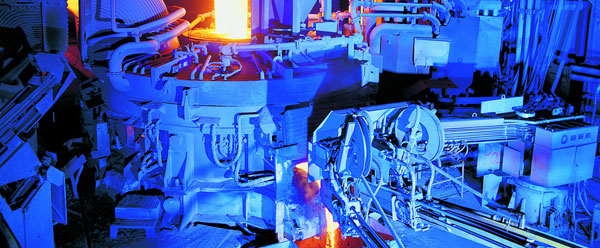Siemens Starts-up World's Largest Direct-Reduction Plant at Hadeed, Saudi Arabia.
 Other News
Other News Subscribe to newsletter
Subscribe to newsletter
| 30 Nov 2007 |
The world's largest direct-reduction plant with an annual production capacity of 1.76 million tons of direct-reduced iron (DRI) was successfully started up by Siemens Metals Technologies for the Saudi Arabian steel producer Saudi Iron & Steel Company (Hadeed).
This facility, located in Al-Jubail on the eastern seaboard of the Saudi Arabian peninsula, is part of a new Siemens-supplied steel mill which was recently started up and is capable of producing 1.4 million tons of flat products per year.
Another highlight of this project is that DRI from the direct-reduction (DR) plant is hot-charged via a so-called hot-transport system directly into the EAF. This solution reduces electric steelmaking costs and results in shorter tap-to-tap times for an increased liquid-steel output.
Hadeed, a company of Saudi Basic Industries Corporation (SABIC), is one of the largest steel producers in the Middle East. The company produces a wide range of long and flat steel products, comprising rebars, wire rods, hot-rolled, cold-rolled and galvanized coils which are primarily used in the construction, petroleum, pipe and household-appliance industries.

The new DR plant is the fifth direct-reduction plant in operation at Hadeed. It is a Midrex-type module of the Megamod series. The shaft furnace, with an inner diameter of 7.0 meters, is the largest shaft furnace built to date. The plant has a production capacity of about 220 tons of DRI per hour, all of which is consumed in the steel-production facilities of Hadeed. The DRI is mechanically transported by conveyor in the hot condition to two EAF hot-DRI storage bins via a so-called hot-transport system.
The conveyor is covered with an insulated steel hood to minimize temperature loss and oxidation of the hot DRI during transport. With this solution, it is possible to charge DRI into the electric arc furnace at a temperature exceeding 650 °C, reducing electrical energy consumption by up to 20 percent for melting work. Shorter tap-to-tap times and a corresponding higher productivity are also achieved in comparison with the charging of cold DRI.
Steel production at Hadeed is based on the melting of scrap and DRI in a ratio of approximately 25 percent scrap and 75 percent DRI. As part of the so-called Steel Plant Expansion Project, Hadeed commissioned Siemens Metals Technologies with projects for the turnkey expansion of the flat-products facility to enable the additional production of 1.4 million tons of steel per year.
This additional output would increase the total annual steel-production capacity at Hadeed to approximately five million tons. This project comprised the supply of the 1.76 Mt/a direct-reduction plant, a 150-ton electric arc furnace (EAF), a 150-ton ladle furnace, a single-strand slab caster in addition to the related dedusting, automation and auxiliary facilities. The new steel mill was built adjacent to the existing flat-steel production facility and production commenced in March 2007. The DR plant was subsequently started up.




